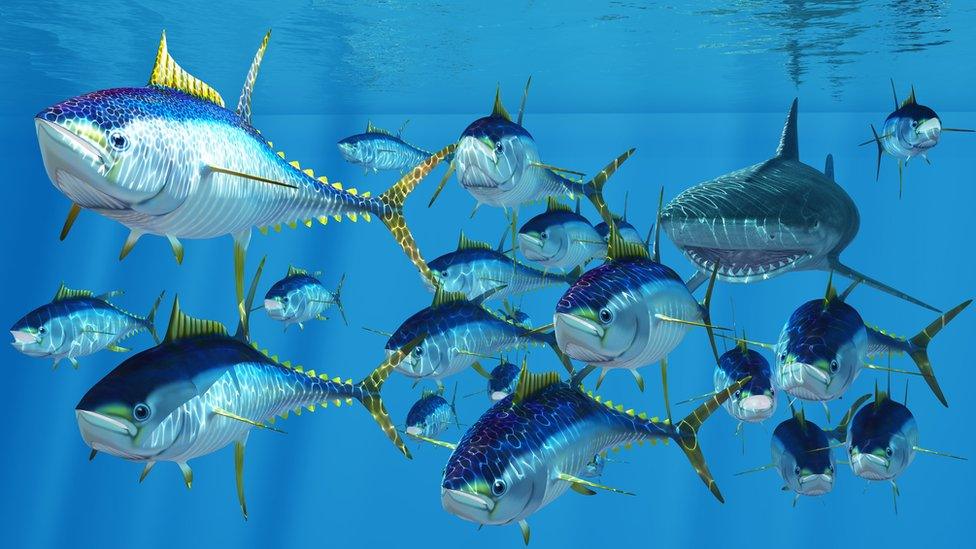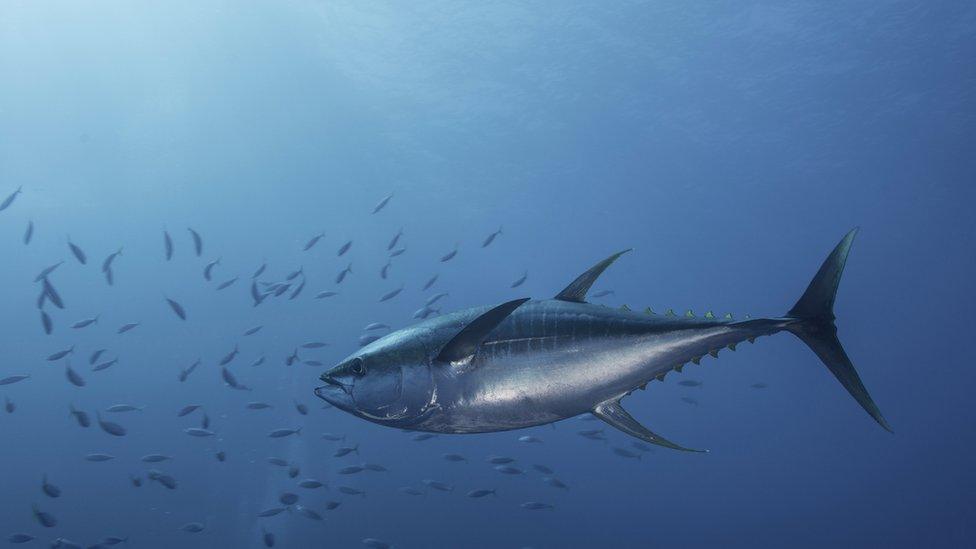Mercury mystery: Poisonous element persists in tuna
- Published

Levels of mercury persist in tuna, decades after pollution controls were introduced to limit emissions, scientists say.
The poisonous element is released by mining and burning coal and ends up in the ocean, where it builds up in fish.
Levels have fallen dramatically in the atmosphere - but remained stable in tuna since 1971.
Very old mercury lurks deep in the ocean and wells up into the waters where the tuna swim, experts say.
Mercury entering marine ecosystems is converted into methylmercury, the most dangerous form of the chemical.
It builds up in tuna when they consume contaminated prey.
And humans are then exposed to the element when they eat the fish, one of the most widely consumed around the world.

Concentrations of mercury in the fish had failed to declined as expected, the researchers found
Mercury poses a particular threat to unborn babies and small children but has also been linked to cardiovascular disease in adults.
Concerns over exposure to mercury have seen governments the world over try to reduce activities that released the chemical into the atmosphere.
The major sources include:
coal and gold mining
coal burning
industry
waste processing
Even the cremation of human bodies with amalgam fillings adds to the total in the air.
Restrictions on many of these activities have seen emissions levels in the atmosphere fall by about 90% since 1990.
And to see if these actions had had an impact on mercury levels in tuna, researchers examined data from nearly 3,000 tuna muscle samples, from fish captured in the Pacific, Atlantic and Indian Oceans, including skipjack, bigeye and yellowfin, which together account for 94% of global tuna catches.
The new work contrasts with other research showing levels of mercury declining in some tuna species.
"We have much more data, more sampling years, and also a broader range of fish sizes," lead author Anaïs Médieu, from the French National Research Institute for Sustainable Development, said.
"This is very important because mercury bio-accumulates during the [lifespan] of the animal. So having a broad range of fish sizes is really important."
Mercury levels in tuna had remained constant between 1971 and 2022, the scientists found, apart from an increase in the north-western Pacific, in the late 1990s, linked to growing mercury emissions in Asia, sparked by rising coal consumption for energy.

Tuna are one of the world's most widely eaten fish
The constant levels may be caused by emissions many decades or centuries ago, the researchers said.
"You have this huge amount of legacy mercury that is in the deeper subsurface ocean," Ms Médieu said.
"This mixes with the surface ocean, where the tuna swim when they feed.
"That's why you have a continuous supply of this historic mercury that was emitted decades or centuries ago."
'Stabilise slowly'
Co-author Anne Lorrain, also from from the French National Research Institute for Sustainable Development, told BBC News: "Our study suggests that we will need massive mercury emissions reductions to see a decrease in tuna mercury levels.
"Even with massive reduction in mercury emissions, our results show that we will have to be patient before seeing a change in tuna mercury levels.
"Overall, it is similar to CO2 [carbon-dioxide] emissions - if we stop emitting drastically, CO2 in the atmosphere will stabilise slowly and finally start to decline. "
The study has been published, external in the journal Environmental Science & Technology Letters.